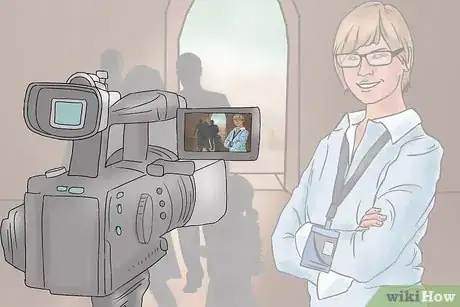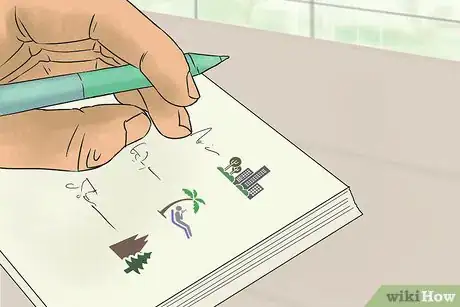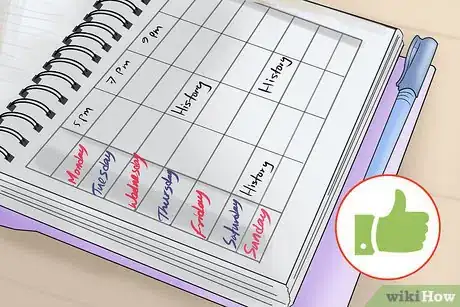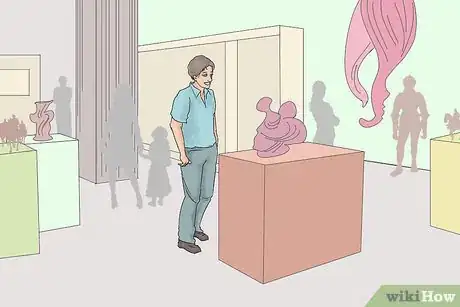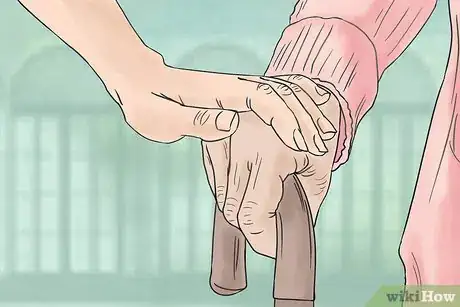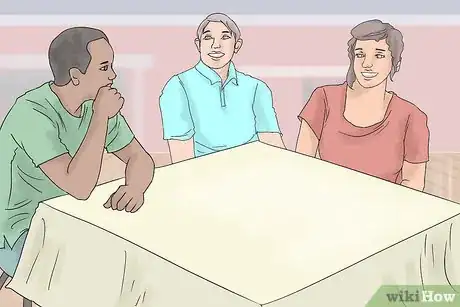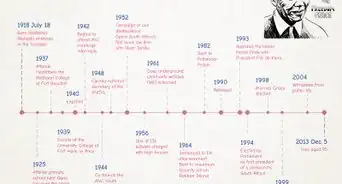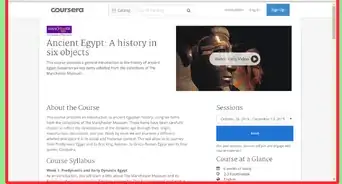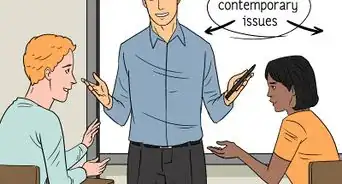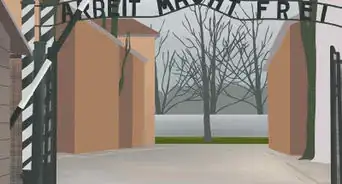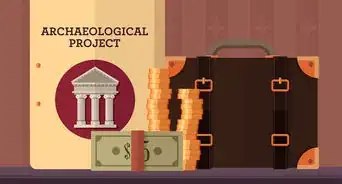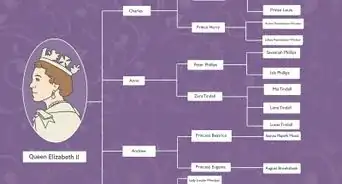This article was co-authored by Emily Listmann, MA. Emily Listmann is a private tutor in San Carlos, California. She has worked as a Social Studies Teacher, Curriculum Coordinator, and an SAT Prep Teacher. She received her MA in Education from the Stanford Graduate School of Education in 2014.
There are 12 references cited in this article, which can be found at the bottom of the page.
This article has been viewed 63,914 times.
If you love history and want to explore the field more, then you are ready to become a history buff! It is time to indulge your history habit and be as knowledgeable a buff as possible. Learn as much as you can about history from your home, and then take your learning outside. Explore museums, sites, and historic homes. Be sure to make lots of time for your favorite hobby.
Steps
Learning from Home
-
1Make a list of your favorite time periods. Make a list of history topics that interest you and do an Internet search to find out what time periods these topics correspond to. Being a history buff is about having fun and making history a hobby, so you will want to start off by learning all you can about the time periods that most interest you. Your list can be as long or short as you want.
- For example, you may be really interested in the history of World War II, the Qing dynasty, ancient Egypt, or women’s suffrage. There are tons of topics to choose from.
-
2Go online to find lists of history and biography books. Use your favorite online search engine to find books about your favorite topics. Write down five titles. Go to your local library and either check them out or see if the librarian can get them from another location.[1]
- It is a good idea to start by checking books out instead of buying them, as this will keep your costs down. You can buy books you absolutely love later.
- If you have never taken advantage of something called interlibrary loan, now’s a perfect time to start! Even if your local library doesn’t have the book you want, they can probably figure out a way to get a copy from another location in the area. And it’s free! Be prepared to wait a couple of weeks for your book, however.
- To start your search, type something like: “best biographies of Eleanor Roosevelt” or “history books about the Great Migration” into the search box.
Advertisement -
3Read historical fiction. Historical fiction is a booming genre with books about pretty much every time period you can think of. Read these books to get connected with history on a personal level. Do not expect fiction to always be historically accurate! Think of this as a fun way to add emotion to the facts you’re learning about from other sources.
- Historical fiction authors sometimes include a section at the end of their books about the research and time period they’ve written about. They will also tell you in these spots what they made up, and what they didn’t.
- There are lots of subgenres to historical fiction. You can find romances, mysteries, and even epic fantasies that are set in various historical time periods.
- To find some popular historical fiction, visit: https://www.goodreads.com/. This site is full of user reviews and recommendations.
-
4Do not just stick to one or two authors. Resist the urge to only read books written by a few authors that you know you like. Historians write about the past in different ways. To be a true history buff, read lots of perspectives. Pay special attention when historians disagree with each other, and use what you have learned to make up your own mind.
-
5Use online resources to find primary sources. Primary sources, like letters, legal documents, journal entries, and photographs, were produced during the actual time period you are studying. Use your favorite search engine to find these sources, as many of them are now available in online exhibits and collections. Explore these sources to get a direct line to the history you love.[2]
- You can find primary sources from the Library of Congress (http://www.loc.gov/teachers/classroommaterials/themes/) and Gilder Lehrman collections (https://www.gilderlehrman.org/collection).
- When analyzing primary sources, consider the purpose of the source, the intended audience, and how the author gets their message across.[3]
- History books and biographies are called secondary sources. They use primary sources as their evidence to make arguments about the past.
-
6Watch historical documentaries. Documentaries are a great way to visualize the past, as they’ll usually use photographs, audio, and video sources to make their films interesting and exciting. Find documentaries about your favorite time periods online or at your local library. Sit down with a bowl of popcorn and enjoy![4]
- Documentarian Ken Burns has made several series about various topics in American history, including World War II, national parks, baseball, the Civil War, and more. These films are a great place to start your documentary education!
Visiting Historic Places
-
1Start with historic sites near your home. Go online to check out what you can you learn about history right in your neighborhood. You’ll likely find local museums, historic homes, and maybe even a battlefield or two. Visit these spots to feel more connected to the places you see on a day-to-day basis.[5]
- Small, regional museums will sometimes have rates for local visitors, so be sure to ask. They may also have yearly membership programs.
-
2Make a list of important spots in your country. It’s a great idea to learn more about your own nation’s past. Go online to find lists of must-see national historic sites. Make your own list based on the spots that interest you most. It may take you a few years to get through the list, but now’s a perfect time to start![6]
- Usually, a nation’s capital is a great place to visit to find several important spots located in the same place.
-
3Decide if there are places you want to see around the world. You can never learn enough about history, especially when you think about it globally. Think about big events or time periods in world history that intrigue you. Make a list of places related to those topics, and start planning trips![7]
- The United Nations recognizes significant sites around the world and compiles them on a World Heritage List, which you can find here: http://whc.unesco.org/en/list/. Browse the list for some great ideas of places to visit!
-
4Go online to find the rules and fees for sites. Before you go to a museum or historic site, be sure to either go online or call. Check their hours, fees, and rules before you arrive to be prepared. It’s important to respect the spots that are allowing you to learn more about history.
-
5Bring a notebook to sites. When you go, be sure to bring a notebook and a pencil. Some museums and sites won’t allow you to bring a large bag inside, so go for a pocket notebook that’s easy to carry. Take notes on things that excite you, important dates or events, and super cool historical figures.
- Look over your notes when you get home that night to commit them to your memory.
- Pencil is better than pen because it’s safer for the historical artifacts. You don’t want to get an ink stain on a priceless painting!
-
6Ask guides questions if you can. If there are guides and they’re not too busy, take advantage! These workers have been trained to answer your questions, so they’re goldmines of information. Write down questions as you think of them, and take notes on the guides’ answers.[8]
- Since you probably have more than one question, be sure to ask the guide if they have time to chat with you. Try saying: “This site really interested me! Do you have time to answer a few questions about it?”
-
7Collect historical artifacts. Finding artifacts from time periods that interest you can help you connect to the historical period. However, you should always verify the authenticity of an item before purchasing it. It’s also important to learn how to care for and preserve the artifacts. Be sure to follow all laws and treaties regarding the sale and possession of historical artifacts.
- For instance, if you’re interested in the Civil War, you could collect uniforms, weapons, and soldier’s letters.
-
8Don’t try to do too much in one day. Never plan to visit more than at most two sites or museums in a day. You’ll get tired and overwhelmed, and you won’t be able to enjoy the spots. Space your trips out, and don’t rush - you’ve got your whole life to be a history buff!
- Visiting just one spot will work even better than squeezing in two.
Making Time for History
-
1Set aside time each week to learn about history. Allow yourself the time to enjoy this hobby. Make it part of your weekly routine to read a history book, visit a museum, or do something else history-related.
- Take notes on books, movies, and other sources as you explore them. You don’t need to memorize every important date or person. However, it’s a good idea to keep track of major turning points in history, along with the names and dates that go along with those big-deal events.
-
2Visit museums or historic sites on your off-days. Since visiting historic sites will likely take at least a half-day, reserve these trips for days you’re not working. Try to visit at least two local sites each month.[9]
- Get your family and friends involved! These can be fun group events.
-
3Plan at least one history-themed vacation each year. For bigger trips that take you out of your neighborhood, plan ahead. These can get pricey, so you may only be able to do one big trip each year, or even every other year. Be patient, and remember there’s no deadline for being a history buff.[10]
- Talk to your family about adding historical themes to your vacations, and add the trips to your yearly budget.
-
4Spend time with older family members. Family get-togethers are perfect times to learn more about your personal history. Ask your older relatives if they’d be comfortable talking about their lives with you. They’ll probably be thrilled, and you’ll never regret having this information. There are some key questions you can ask, including:[11]
- “What’s your first memory?”
- “Can you tell me about where you grew up, and what it was like in your neighborhood?”
- “Was there ever a major turning point in your life?”[12]
- “Do you remember what it felt like to live through times of national crisis?”
- “What are some of the most important changes in the world you’ve noticed as you’ve gotten older?”
- Ask if you can record the conversation on your smartphone. You can type it up later and circulate it among your family members.
-
5Join a history-themed trivia team for fun. Go online to see if any local spots host a history-themed trivia night. If you can’t find one, organize one of your own! See if a popular restaurant, bar, or coffee shop will host and advertise it. Get more people to come by asking funny and cool questions about history.
- Ask your friends and family members if they’d be interested in doing trivia with you.
- If you’re under 21 and living in the United States, you probably won’t be able to attend trivia nights at bars. Try for restaurants or coffee shops instead.
- Random, obscure facts about history are usually the ones that interest people, and they make for harder trivia questions. You can go online to find lists and articles dedicated to offbeat historical facts.
Community Q&A
-
QuestionIf your mom was a history major, does that mean you can ask her about history?
 Community AnswerAbsolutely! Your mom sounds like a great resource to learn more about history. If you're hoping for her help on homework, she may want to make sure she's not doing the work for you. But if you're both history buffs, you can enjoy sharing this interest.
Community AnswerAbsolutely! Your mom sounds like a great resource to learn more about history. If you're hoping for her help on homework, she may want to make sure she's not doing the work for you. But if you're both history buffs, you can enjoy sharing this interest.
References
- ↑ http://www.randomhousebooks.com/lists/list-for-history-buffs/
- ↑ https://www.loc.gov/exhibits/
- ↑ https://www.carleton.edu/history/resources/history-study-guides/primary/
- ↑ http://topdocumentaryfilms.com/category/history/
- ↑ https://www.travelwisconsin.com/article/things-to-do/top-25-wisconsin-historic-sites
- ↑ http://time.com/4792728/historic-sites-recommendations/
- ↑ http://www.smithsonianmag.com/travel/best-cafes-history-buffs-180962692/
- ↑ https://www.motherofalltrips.com/2011/09/tips-for-visiting-colonial-williamsburg-with-kids.html
- ↑ https://learning.blogs.nytimes.com/2013/11/11/what-are-the-best-ways-to-learn-about-history/





